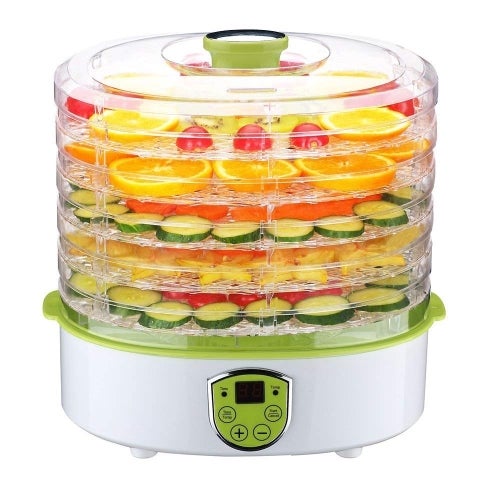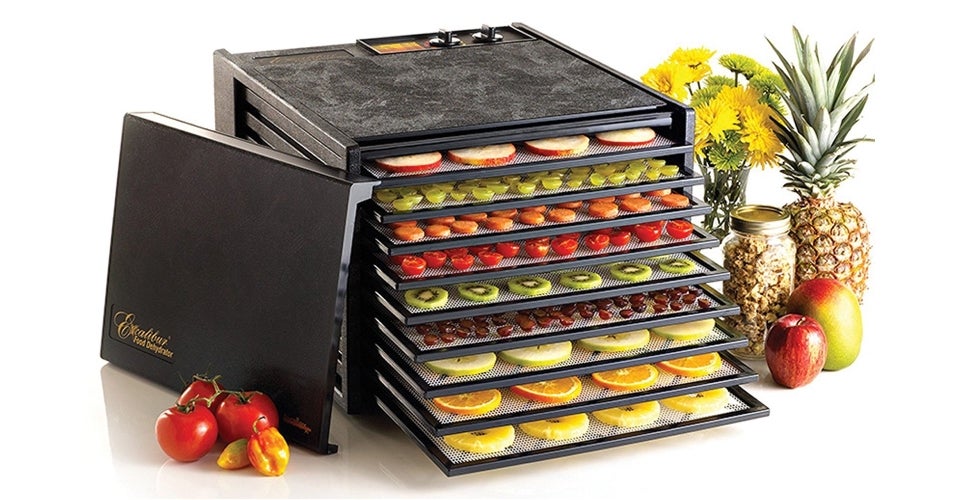
Our Editors independently research, test, and rate what we feel are the best products. We use affiliate links and may receive a small commission on purchases.
Dehydrating food is one of the easiest methods for preserving and storing food, while retaining important nutrients. It’s easy, economical, and perfect for large families, hikers and backpackers, avid gardeners, and sportsmen alike.
We have created a buyer’s guide entitled, How To Choose A Food Dehydrator. And break down the 6 top-rated best food dehydrators.
Best Food Dehydrators
| Excalibur 3926TB 9-Tray Dehydrator | STX Dehydra Commercial Grade Dehydrator | Excalibur 3900B 9-Tray Food Dehydrator | |
|---|---|---|---|
| Adjustable | Adjustable thermostat (105 to 165 degrees F) for use with meat jerky or fruits and vegetables | Adjustable thermostat (95 to 165 degrees F) for use with meat jerky or fruits and vegetables | Adjustable thermostat (105 to 165 degrees F) for use with meat jerky or fruits and vegetables |
| Drying space | 15 square feet of drying space | 16 square feet of drying space | 15 square feet of drying space |
| Special Features | Includes polyscreen tray inserts to prevent sticking, 26 hour timer | 15 hour timer, Commercial/industrial grade | Includes polyscreen tray inserts to prevent sticking |
| Customer Ratings | 4.5 / 5.0 Stars | 4.5 / 5.0 Stars | 4.6 / 5.0 Stars |
Also see: Food Dehydrators – Price Comparison Table
Quick Answer: The 6 Best-Rated Food Dehydrators
- Excalibur 3926TB 9-Tray Electric Food Dehydrator
- STX Dehydra Commercial Grade Stainless Steel Food Dehydrator
- Excalibur 3900B 9-Tray Electric Food Dehydrator
- Chefman 9-Tray Food Dehydrator Machine
- Nesco FD-75A Snackmaster Pro Food Dehydrator
- Greatic Household Digital Multi-Tier Food Dehydrator
Food Dehydrators Reviews
#1 – Excalibur 3926TB 9-Tray Electric Food Dehydrator
![]()
- Adjustable thermostat (105 to 165 degrees F) for use with meat jerky or fruits and vegetables
- 15 square feet of drying space
- Includes polyscreen tray inserts to prevent sticking
- No food or tray rotation required
- 26 hour timer
The Excalibur 3926TB is the Cadillac of food dehydrator machines. It is priced accordingly, but for dedicated at-home food dehydrators, this is the prime choice.
Made in the USA, this dehydrator uses Excalibur’s patented Parallex Horizontal Airflow to provide fast and even drying.
Also the Hyperwave Fluctuation technology keeps the food temperatures low enough to maintain active enzymes but high enough to safely preserve food.
This fluctuation of temperature eliminates ‘case hardening,’ a common problem with constant-temperature dehydrators where the food has a dry exterior but there is moisture trapped inside, which can allow mold and bacteria to thrive and ruin the food.
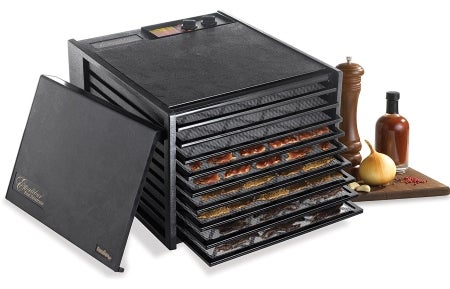
The adjustable thermostat and timer allow for a multitude of uses, including dehydrating fresh fruits, vegetables, and herbs, making jerky from meat or fish, creating preservative-free fruit roll-ups and snacks.
Or for making all-natural pet treats, drying flowers for potpourri and other craft applications, rising bread dough, making homemade yogurt, and more. Removable trays make it super simple to raise dough or dehydrate larger items.
This Excalibur dehydrator is a front-loading design with rectangular trays. The unit is 12.5 inches tall by 17 inches wide by 19 inches deep, and offers 600 watts of heating power.
The 7-inch circulating fan, heating element, and thermostat are located on the back of the unit.
The BPA-free trays are easy to clean and even dishwasher safe, and the non-stick polyscreen tray inserts are useful for extra sticky foods.
Solid trays as opposed to mesh mean you can easily dehydrate small items like hashbrowns, garlic, etc. without worrying about them falling through the mesh.
#2 – STX Dehydra Commercial Grade Food Dehydrator
- Adjustable thermostat (95 to 165 degrees F) for use with meat jerky or fruits and vegetables
- 16 square feet of drying space
- 15 hour timer
- Commercial/industrial grade
It has a hefty 1200 watts of heating power and measures up at 15 inches tall by 17.5 inches wide by 20 inches deep. Like the Excalibur, it has rectangular trays and rear-mounted 7-inch fan.
However, it differs in that the dehydrator trays are ¼-inch stainless steel mesh, which allows for more airflow but also allows small pieces of food to slip through the mesh – reviewers mention that even banana chips will fall through as they shrink.
There is a drip tray included, but if you plan to dehydrate small food items, keep in mind that you will need to purchase an additional tray with smaller mesh, or use parchment paper or a silicon mat on top of the mesh.
But, if you plan to use this as a commercial dehydrator for larger items such as jerky, it’s an excellent choice with a huge capacity. The 15-hour timer does mean that you will have to manually restart it on longer dries though.
#3 – Excalibur 3900B 9-Tray Electric Food Dehydrator
- Adjustable thermostat (105 to 165 degrees F) for use with meat jerky or fruits and vegetables
- 15 square feet of drying space
- Includes polyscreen tray inserts to prevent sticking
- No food or tray rotation required
It has the same dimensions, power output, and dehydrating technology – but by setting your own timer you can save about $100.
You can also purchase a separate timer, then plug the dehydrator into the timer and the timer into the wall, so the power will be cut off the same way as with the 3926TB.
Many reviewers mention that due to humidity and temperature, dehydrating time can vary drastically, and it’s best to monitor your food visually rather than depending on a timer anyways.
#4 – Chefman 9-Tray Food Dehydrator Machine
- Adjustable thermostat (95 to 158 degrees F) for use with meat jerky or fruits and vegetables
- 75 square feet of drying space
- 5 hour timer
- Dishwasher-safe BPA-free plastic trays
This unit features a transparent plastic door that allows you to easily monitor the drying process without having to open the door. It has 480 watts of heating power and measures 14 by 17 by 18 inches.
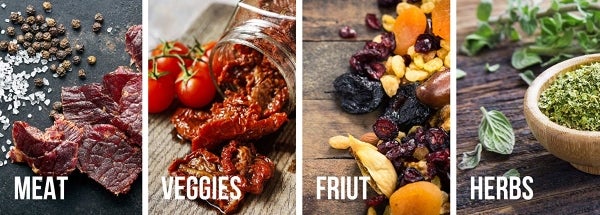
Several reviewers mentioned problems with being able to open the door when they first received the unit, but that the problem was easily remedied when they discovered and removed the piece of cardboard packed between the back of the trays and the heating element.
We think that’s something that the manufacturer should make note of in the manual, even though it is fairly obvious upon inspection.
One other item to note about this dehydrator is that the temperature controls only allow you to choose from increments of 9 degrees Fahrenheit, so for some recipes you will not be able to select the exact recommended temperature. This is a minor inconvenience though, and the simplicity and ease of use outweigh that by far.
#5 – Nesco FD-75A Snackmaster Pro Food Dehydrator
- Adjustable thermostat (95 to 160 degrees F) for use with meat jerky or fruits and vegetables
- Comes with BPA-free plastic 5 trays, but expandable to 12 trays – 1 square foot of drying space per tray
- No need to rotate trays
- Top mounted fan
- Round design
It has 600 watts of drying power and it comes with a variety of mesh and solid trays, with more available for purchase.
This unit also utilizes an opaque Vita-Save exterior surface, which is designed to block out harmful light rays that could compromise your food’s nutrients and vitamins. The Nesco’s Converga-Flow drying system means you don’t have to rotate trays mid-dry. A 52-page recipe and instruction book is included to help beginners get started.
This dehydrator is great for the price point, but be aware that some users have reported discrepancies in the actual temperature versus the setting – by as much as 25 degrees Fahrenheit.
While that won’t be a problem for food items like fruit and vegetables, it could pose a safety risk when preparing jerky so be sure to double check the internal temperature of any meat products and cook using another method if necessary after dehydrating.
#6 – Greatic Household Digital Multi-Tier Food Dehydrator
- Adjustable thermostat (95 to 158 degrees F) for use with meat jerky or fruits and vegetables
- 5 moveable trays
- Round design
- Transparent so you can monitor drying process
- Up to 72 hour timer
At only 240 watts of drying power, it does take quite a bit longer than the other units we have reviewed here.
The unit includes a timer that can be set anywhere up to 72 hours, and the manufacturer recommends to limit each use to 72 hours maximum to avoid damaging the machine.
The Greatic dehydrator has two options for tray settings: one where the trays are closer together for drying smaller items, and one where there is more space between the trays for larger items. The plastic trays are easy to use and wash.
Food Dehydrators – Price Comparison Table
| Food Dehydrators | Adjustable | Drying space | Special Features | Customer Ratings | |
|---|---|---|---|---|---|
| Excalibur 3926TB 9-Tray Electric | Adjustable thermostat (105 to 165 degrees F) for use with meat jerky or fruits and vegetables | 15 square feet of drying space | Includes polyscreen tray inserts to prevent sticking, 26 hour timer | 4.5 / 5.0 Stars | |
| STX Dehydra Commercial Grade | Adjustable thermostat (95 to 165 degrees F) for use with meat jerky or fruits and vegetables | 16 square feet of drying space | 15 hour timer, Commercial/industrial grade | 4.5 / 5.0 Stars | |
| Excalibur 3900B 9-Tray Electric | Adjustable thermostat (105 to 165 degrees F) for use with meat jerky or fruits and vegetables | 15 square feet of drying space | Includes polyscreen tray inserts to prevent sticking | 4.6 / 5.0 Stars | |
| Chefman 9-Tray Food Dehydrator | Adjustable thermostat (95 to 158 degrees F) for use with meat jerky or fruits and vegetables | 75 square feet of drying space | 5 hour timer | 4.5 / 5.0 Stars | |
| Nesco FD-75A Snackmaster Pro | Adjustable thermostat (95 to 160 degrees F) for use with meat jerky or fruits and vegetables | 1 square foot of drying space per tray | No need to rotate trays | 4.6 / 5.0 Stars | |
| Greatic Household Digital Multi-Tier | Adjustable thermostat (95 to 158 degrees F) for use with meat jerky or fruits and vegetables | Transparent so you can monitor drying process | Up to 72 hour timer | 2.9 / 5.0 Stars |
How to Choose a Food Dehydrator
Choosing the best food dehydrator for your needs can be complicated. When choosing a food dehydrator, there are several factors to consider. First, consider your capacity needs.
Capacity
If you are going to be dehydrating massive quantities of food for a large family or group, opt for a larger unit with a fast drying time. If you only plan to casually use the dehydrator and only for one or two people, a smaller and cheaper unit would be more appropriate.
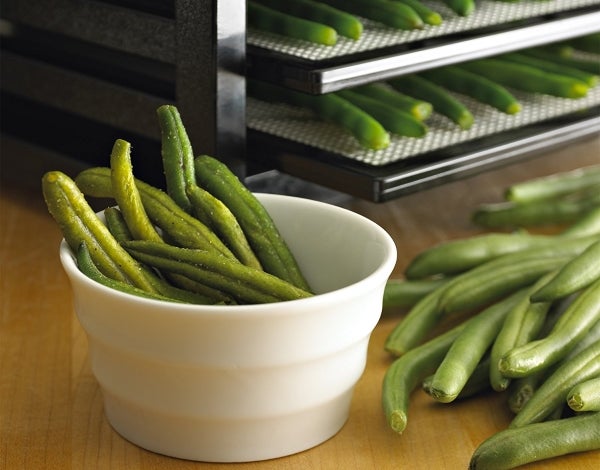
Food Types
Second, consider what types of food you plan to dehydrate and choose a dehydrator that’s designed accordingly. For instance, if you plan to make jerky, you will need a unit that can reach a high enough temperature to meet food safety regulations.
If you plan to dehydrate small pieces of food, opt for a unit that includes solid trays as opposed to mesh so items don’t fall through as they shrink.
Budget
Finally, keep your budget in mind. The units we’ve reviewed above range from about $60 to about $300, so there’s an option for everyone.
If you are going to use the dehydrator daily, it would be worth it to invest in a heavier duty high quality unit. For casual use, a less expensive model might be your best option.
FAQs – Frequently Asked Questions About Food Dehydration
- What are the benefits of food dehydration?
- What kinds of things can I dehydrate?
- Can I dehydrate multiple types of food at once?
- How long does it take to dehydrate food?
- How do I store my dehydrated foods?
- Why doesn’t my dehydrated fruit look like what I buy in stores?
- Will the dehydrating machine be noisy?
Question: What are the benefits of food dehydration?
Answer: Dehydrating food is a safe, easy, and cheap way to preserve food. You can save money by buying food in bulk and then preserving it so nothing goes to waste.
It is much cheaper to make your own fruit chips and jerky than to purchase premade options in stores, plus you can customize your food exactly to your own taste preferences.
Dehydrating your own food also allows you to eat healthier, since there are no artificial preservatives added, and properly dehydrated food retains almost all of its nutrients, vitamins, and minerals.
Dehydration is also a perfect solution if you have a bountiful garden or hunt, as you can preserve the sudden influx of food items when the garden is ready for harvest or you bag a large game animal, without letting any go to waste and without having to eat all of it right away.
Question: What kinds of things can I dehydrate?
Answer: There are a multitude of uses for a dehydrator – you can dry fruits, vegetables, herbs, meat, fish, nuts, and more. You can also use a dehydrator to make fruit leather, yogurt, pet treats, soup mixes, craft projects, potpourri, and raise bread dough.
You can even dehydrate prepared meals to use when when camping or backpacking, since you can simply reconstitute them later with water and have a hot meal without the prep.
Question: Can I dehydrate multiple types of food at once?
Answer: Yes, as long as they are in the same general food family – i.e. fruit with other fruit, veggies with other veggies, etc.
Due to the high temperature requirements for making jerky, we recommend doing meat-only batches without mixing in other foods. Additionally, onions should not be dehydrated with any other foods as the potent onion flavor will taint the other foods.
Question: How long does it take to dehydrate food?
Answer: The short answer is: it depends. A variety of factors play a role, including the temperature and humidity of where you are, the amount of food you are drying at once, the type and size of food items (for instance, meat jerky takes longer than vegetables), and the heating power and temperature setting of your dehydrator.
Many units come with an instruction manual and recipe book that will include guidelines for how long to dehydrate certain types of foods. When in doubt, let the food cool for a few minutes and then feel it – if it’s leathery and pliable, it’s probably done, but if it feels moist or sticky, it needs more time.
Question: How do I store my dehydrated foods?
Answer: Store your dehydrated food in airtight containers, away from heat and direct light. Ideally food should be stored in a cool and dry place like a pantry. Exposure to moisture will greatly decrease the shelf life of your dehydrated food.
Most dehydrated foods can be safely stored for up to one year. If you choose to vacuum pack, refrigerate, or freeze your food, you can expect to double or triple the shelf life.
Question: Why doesn’t my dehydrated fruit look like what I buy in stores?
Answer: People often expect that dehydrated banana chips will look and taste like the ones they buy in stores, but the truth is that store-bought chips are often deep-fried as opposed to dehydrated.
Homemade ones will taste different and have a less crunchy texture, but they are much healthier and not soaked in fatty oils and artificial sweeteners and preservatives.
The same goes for other dehydrated fruits, such as apples. Dehydrated apples often turn brown, simply because they have oxidized from being exposed to the air. They are perfectly safe and delicious to eat, but if you’d like to make them more visually appealing, you can pretreat the fruit before dehydrating to minimize oxidation.
This can be done by dipping the fruit in a mixture of fruit juice and water, which creates a natural barrier between the flesh of the fruit and the air, without altering the taste or nutritional value.
Question: Will the dehydrating machine be noisy?
Answer: These machines will definitely produce some noise, as they require a fan to be constantly running to evenly disperse the hot air inside. However, it’s a constant white noise and many users compare the noise level to a running microwave. If you need to run the dehydrator overnight, it shouldn’t keep you awake unless you are a very light sleeper. You can always place the unit in a garage or somewhere away from your main living area if the noise disturbs you. Alternately, start the dehydrator right when you wake up in the morning, and most food items will be done drying before you are ready to go to sleep that night.
Buyer’s Tips
Read user reviews online before you purchase. You can glean a lot of information that the manufacturer might not share by reading about other consumers’ experiences with the item.
Compare prices across multiple shopping channels. While Amazon frequently offers free shipping and low prices, other stores may have sales or promotions that end up giving you a better deal. Investigate all your options.
Check out the warranties for each unit. Nothing is worse than receiving an appliance and then having it get damaged in shipping or stop working soon after you receive it. A good warranty can give you peace of mind when making a purchase.
Thanks for reading The 6 Best Food Dehydrators. We hope this article has helped you to discover the best choice for your needs when selecting a food dehydrator.
And if you’re shopping for other gear take a look at these related review articles from Outside Pursuits:
HOME & GARDEN LED GROW LIGHTS | HYDROPONICS SYSTEMS | GROW TENTS | HYDROPONIC NUTRIENTS | HYGROMETERS | SOIL PH METERS | HERB GARDEN KITS | LED LANDSCAPE LIGHTS | LED SOLAR LIGHTS | FOOD DEHYDRATORS | COOLER ICE PACKS | BUG ZAPPERS | WHEELBARROWS | PRUNING SHEARS
How We Researched
To come up with the top food dehydrators, we researched a variety of sources for reviews such as Home Depot, Lowes, Target and Wayfair along with our own personal experience.
We also consulted online magazines for product research and reviews to get as much unbiased information as we could. To help weed out fake reviews we used Fakespot.com to make sure we only looked at genuine reviews.
With so much quality gear available, we had to narrow it down based on what we felt were the best options were for the price. The staff authors have a wide and varied background in yard design and home repairs.
The authors have decades of experience and are eager to share their knowledge with readers.
To help narrow down the selection we used personal experiences along with recommendations from landscapers, bloggers and contractors.
After extensive research, we came up with our list to help you choose the right one for you.

